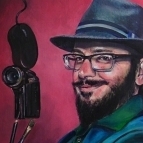-
Posts
124 -
Joined
-
Last visited
Content Type
Profiles
Case studies - Free
Case studies - Premium
Resources
Insider
Courses
Forums
Store
Everything posted by Lee Lanier
-
Good to know. Thanks.
-
As soon as you click the Update LUTs button, the Resolve LUT menus are updated. DCTLs are text files, so you could cut and paste the DCTL text on the GitHub page into a new file using a program such as Windows Notepad. Just make sure the extension is .dctl when you save out.
-
One option is to move all the clips into a single camera color space and use that camera color space for the timeline color space. For example, use DCTL to transform one camera color space to another. Another option would be to work in RCM Extra Wide Gamut, which has a larger gamut then any particular camera color space.
-
Thanks. I'm actually recording a new version of this course, which should be available sometime in the relative near future. There will be additional information on mixing SDR with HDR and tone mapping.
-

Tracking Complex Surfaces in Nuke 13 & Mocha
Lee Lanier commented on Sjors Krebbeks's course in Finishing & VFX
The button seems to be dead. I will let the website manager know. -
That depends on the shot, but for a 2D extension you would probably need to create a larger domain for the extended set with a tool like Crop, motion track the extension art with the Tracker, and then re-crop the final result to the final render size.
-

Background Clean-Up in After Effects
Lee Lanier commented on Lowepost's insider article in Color Grading
That depends on the shot, but for a 2D extension you would probably need to create a larger domain for the extended set with a tool like Crop, motion track the extension art with the Tracker, and then re-crop the final result to the final render size. -

Tracking Complex Surfaces in Nuke 13 & Mocha
Lee Lanier commented on Sjors Krebbeks's course in Finishing & VFX
My node network directionality is an ingrained habit built over many years. I will keep the suggestion in mind for the next course, or at least mention it as a common approach. -

Tracking Complex Surfaces in Nuke 13 & Mocha
Lee Lanier commented on Sjors Krebbeks's course in Finishing & VFX
Thanks for your input. I'll admit I can be unorthodox in my technique and a little obtuse with my explanations, but I firmly believe there are multiple approaches to every VFX problem. I would encourage all VFX artists to stay flexible, seek out information from multiple sources, and follow the standards set by the particular studio, project, or supervisor you working for. -

The Essential Guide to Motion Tracking Types
Lee Lanier commented on Lowepost's insider article in Video Gear
The Mocha planar tracker is extremely good and generally outperforms transform or corner pin tracking in other programs. The new mesh tracker is cool, but it does not work in all situations. For example, significant changes in lighting or deformations on a surface with little color variation can prevent it from working. -
Looks like an error you'll get when you choose New Database with the Create option. Make sure you use the Connect option and that you choose the directory by clicking next to Location.
-
Good suggestion. I did want to demonstrate mesh importation, but there is a lot you can do with primitives.
-
Glad you worked it out.
-
That, I do not know as I spend little time in the Edit tab. I'm afraid I would have to spend some time trying to figure that out myself...
-
Lesson 5 shows how to combine the stereo images to make a top/bottom or side-by-side combination, which you can then pass through a single MediaOut tool (useful for VR applications). If you need to render the left and right separately, then, yes, you would have to render them individually or pass them through two MediaOuts (you can have more than one).
-
Theoretically, it should be the same exact process for any supported format. Sounds like it's having trouble reading your files. Can you test some other footage - other QuickTimes? I use a PC to run Resolve, so I'm not sure if there are any Mac issues.
-
The only thing I can think of is syncing the audio outside of Fusion or through a set-up project for re-rendering.
-
Glad to hear it. Thank you for checking it out.
-
Good question. That would be useful.
-
Lesson 12 shows some techniques that would be useful for hair.
-
If you use RCM, make sure the Input Color Space is is set to your camera log space. Set the Output color space to Rec. 709. Then, it's up to you if you want to have the Timeline color space (the space your grade in) set to your camera space or Rec. 709. Lesson 7 will walk you through RCM.
-
We are in the process of re-uploading the old project files, so stay tuned.
-
We just updated this course to cover wide gamut, new HDR features, DRTs, and other changes with version 17. The videos on this page have been updated and new videos have been added.
-
I find Fusion a little awkward for extensive rotoscoping,, but the built-in tracking features can help make it easier. It would be worth checking out my advanced Fusion rotoscoping course at Lowepost. I use After Effects quite often because it's very simple and straightforward, plus the Mocha tracker is excellent.


